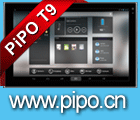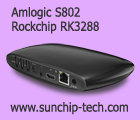This is Samsung’s new ARM Cortex-A9 processor. Probably, I expect, the processor that will be in the next generation of Galaxy S and Galaxy Tab type of products from Samsung and from manufacturers who will want to use Samsung’s processor in their products. My guess is it may also be fast enough to power Samsung laptops with Chrome OS or some other type of embedded Linux. It seems also to be the first demonstration of Mali-400, to be confirmed. Samsung representatives were not able to confirm anything on this processor at this point.
Linaro Graphics Group at ARM Techcon 2010
An interview with the leader of the Linaro Graphics Group on the status of graphics acceleration in Linaro and how important that is for a smooth experience of advanced user interfaces on ARM Powered devices.
Freescale Kinetis Tower System now sampling
The Freescale Tower systems are development kits providing for many of Freescale’s sensors and processing features in a cube. The new Freescale Kinetis ARM Cortex-M4 processor and this Kinetis Tower System just started sampling now.
Linaro CEO George Grey at ARM Techcon 2010
Linaro’s goal is to make it easy for manufacturers to make ARM based devices, from smart phones, tablets, set-top-boxes, cars, even desktops, laptops and servers.
MDK-ARM and ULINKpro at ARM Techcon 2010
ULINKpro, together with MDK-ARM, provides extended on-the-fly debug capabilities for Cortex-M devices.
John Bruggeman of Cadence on EDA360 at ARM Techcon 2010
John Bruggeman of Cadence and Simon Segars of ARM just hosted a pretty awesome fireside chat at the ARM Techcon (full length video of which I will link to here once it is up). discussing areas in which ARM industry should cooperate more and where they can differentiate themselves and push the technology forward faster. Cadence is an EDA provider which means they provide software tools for designers of ARM Processors. The fireside chat includes discussions on standardization of Linux on ARM, supporting drivers, implementing security at the hardware level (see my video of ARM TrustZone), and how John Bruggeman thinks competing EDA providers should agree on how to collaborate on certain areas to focus on competing on others and bring the industry forward faster. Cost of designing a new ARM Processor should be cut by a factor of 5 he says if these industry players could figure out to better collaborate on the core tools. The goal is for companies that provide solutions and tools that enable always cheaper ARM Powered devices to consumers, that cost to build basic things should be built collaboratively so suppliers can save money on basic stuff and focus on differentiation. $100 Android phones and $400 HDTVs should still allow device makers and the industry that supports the creation of these tools to make a profit. In a constantly disruptive industry with cheaper and cheaper ARM Powered devices, but at the same time with more and more complicated, more advanced, soon reaching Nanotechnology scales ARM Powered devices, it is interesting to imagine how all these companies plan to continue to make a profit.
VisualOn provides ARM Powered video playback without hardware acceleration
VisualOn is demonstrating that they can provide solutions for ARM9, ARM11 and ARM Cortex-A8 and -A9 processors, where the playback of all video codecs, in certain cases at up to 720p can be supported by using the ARM part of the processor only, not even needing to use a DSP to hardware accelerate the video playback. It is still to be confirmed exactly what resolutions and bitrates are supported for each specific level of ARM Processor performance. For uses like adding support for RMVB, WMV and certain types of video streaming on top of regular HD decoding hardware, then this could be a good solution for those types of people. It integrates seemlessly as a Native SDK based application on top of Android.
I am video-blogging ARM Techcon starting tomorrow
I have arrived here in Santa Clara California, just a few kilometers from Google’s Mountain View, Yahoo and Cisco are the other side of the street, Apple is in the next city 10 minutes from here. This is the Silicon Valley. Tomorrow starts the ARM Technology Conference here at the Santa Clara convention center. I will be video-blogging perhaps as many as 30 videos during these next few days. Make sure to often refresh my RSS feed during these next few days (starting Tuesday November 9th Pacific Time) and check back for lots of awesome ARM related videos coming up!
Just few days before the rumored Nexus Two and Gingerbread (I may have seen a couple of engineers waving it around a bar in Mountain View just a couple of hours ago..), within a couple weeks from the rumored Chrome OS ARM Powered laptops, TI, Nvidia and others have ARM Cortex-A9 devlopment kits and actual products hitting the market now or soon, the ARM Cortex-A15 was just announced! I expect there will be a lot of fascinating videos to film, demonstrating the products and technologies, interviewing engineers and specialists from ARM and from all the companies making ARM Processors and products!
I want to learn more about the performance of ARM Cortex-A9 for full desktop/laptop computing. Is full web browsing speed going to happen soon? What specific kinds of faster I/O and faster memory designs are required for ARM Powered laptops and desktops to hit mass production and usage by all consumers?
Which are the best ARM Powered tablet platforms? How are they customizing Android for tablets or which other software solutions and hardware acceleration is being worked on?
What is the status of Linaro, is it going to support a software foundation for full desktop/laptop computing on ARM Powered devices? What are going to be the hardware requirements?
Do ARM Powered solutions support full 1080p video decode and encode, at full high bitrates with high profile encodes of most requiring MKV containers with all the required codecs? If so, what’s needed for ARM to power the Google TV? How soon will ARM be usable for Google TV based devices?
What’s up with the next generation of 1080p camcorders, will their encoding qualities be increased (better encoding quality at lower bitrates) and can ARM Powered solutions be used for the most cost effective HD video-conferencing solutions?
How are the ARM chip providers designing those processors? How do they manufacture them? How do they plan to make them faster, smaller, cheaper and better? How long does it take to integrate them in products that can be mass manufactured and sold to consumers?
What would you like me to ask the people representing these ARM related companies during this conference? Post your questions in the comments and I will try to ask them directly to the engineers in charge of all the aspects of the ARM industry! Do you want to ask anything to ARM, Freescale, TI, Samsung, Marvell, Qualcomm and any of the other attendees or exhibitors at this conference? Let me know what I should ask and who I should Interview! You can also let me know what I should film at my email charbax@gmail.com and to my phone number while I am in the USA: +1 (702) 238 8630
7″ Pixel Qi may be shown at CES
According to the new Pixel Qi products page at http://pixelqi.com/products, the 7″ version of the Pixel Qi screen, thus suitable for more portable tablet form factors and e-readers, may be on display and perhaps available as samples starting this January at the CES trade show.
7″ samples for CES 2011 possible
And according to their September 17th blog post:
New Screen Development: 7″
We are developing a 7” screen for tablets and ereaders that is planned for mass production in H1 2011. Samples will be available earlier, perhaps by late Q4 2010.
As I am typing this post on my awesome 7″ Archos 70 Internet Tablet, I can imagine how it would be to have the device be even lighter (than its current 300 grams, vs 380 grams Galaxy Tab and 680 grams iPad) with a smaller battery or to have it last upwards 50 hours with a reflective screen suitable for e-reading. Kindle 4 should definitely use this, and this is I think the reason for Amazon to be secretly preparing their alternative Android application store.
Source: pcworld.com
Video about my E-Ink watch
I am being video interviewed by Sasha Pallenberg of netbooknews.com about my awesome E-ink watch:
It doesn’t exactly have the Bluetooth features, those features will come with the also cool looking touch screen Sony Ericsson Liveview and similar Android Bluetooth remote control watches that are coming.
This video was released at: netbooknews.com
netbooknews.com: LG Optimus P500 Android Smartphone
Nicole of Netbooknews reports from the LG Optimus press conference in Taiwan. The phone is a 480×320 3.2″ Android phone to retail unlocked for about $332 in Taiwan. It uses the 600Mhz ARM11 Qualcomm MSM7227 processor.
This video was released by: netbooknews.com
OLPC XO-3 unbreakable Pixel Qi to show after CES
OLPC is working to design an unbreakable screen and thus may not have the XO-3 prototypes ready to show at CES in January. Marvell and its partners will likely have lots of tablets to show by then though. An unbreakable and sunlight readable Pixel Qi screen is an important feature of the XO-3 to make it a viable option for developing countries, as well as its abilities to be used for full productivity and for fast text input.
Source: pcworld.com
Super AMOLED 7″ to come next year
Samsung will show the Super AMOLED screen in 2 weeks at the FPD-International exhibition in Japan, but production won’t start before middle of next year when Samsung’s upcoming new Super AMOLED factory is ready to produce larger amounts of these new screens.
Super AMOLED is pretty awesome screen quality, though by then, I would like to also see 4″, 5″, 7″, 10″, 11″, 13″ Pixel Qi LCDs in all tablets, laptops, turning them all into perfect e-readers for outdoor use and with battery runtime upwards 50 hours.
The big question is how much more expensive is Super AMOLED compared to LCD and how much difference in price will it have next year? If people keep buying $500 devices next year, then Samsung can use Super AMOLED and absorb the price difference as a differentiator as those prices are so high. But if $100 Android tablets are common by then, then possibly there won’t be enough demand to justify a 7″ Super AMOLED screen if the manufacturing price is more than double the price of good capacitive Pixel Qi LCD screens.
Chrome OS ARM Powered laptops could debut this month!
Inventec may be preparing to ship 60-70 thousand ARM Powered laptops running the Chrome OS laptop starting later this month according to Taiwan based rumor and fact website Digitimes.com. This may be the absolute demonstration of the shifting trend to come in laptops, where Intel and Microsoft will not be needed anymore and laptops can run ARM Cortex processors with fast I/O, good RAM, flash based storage, very thin and light form factors with very long battery runtime and instant boot, all running full Chrome web browser OS, one that loads all websites at full speed and provides fast web browsing.
Can the ARM Powered laptops run a web browser at full speed, this will be the start of the revolution, as full speed web browsing is the main performance requirement for a mass consumer laptop product. If an average consumer and experts are able to browse the Internet on the ARM Powered Chrome OS laptop at similar or better speed than current Intel Atom based laptops, then this should mean the success of this platform.
See my video of an ARM Powered Inventec laptop presented at Computex 2009: Inventec ARM Laptop powered by Snapdragon also see the pocketable laptop form factore presented by Invented at Computex 2010: Inventec Dr eye and try to imagine the progress Inventec has been able to achieve for a Chrome OS type of full sized laptop platform since then.
Which processor do you think is going to be used for Chrome OS ARM Powered laptops? Do you think ARM Cortex-A9 will be a requirement? How much RAM? And how do you think they achieve fast enough I/O bus speeds to provide for a full performance web browsing system? Do you think ARM Powered Chrome OS devices will provide a full Native Code, Flash, 3D, local storage and fast javascripts/ajax support that can be required?
My opinion: If they ship it for $199 out of any contracts, with a good ARM Cortex-A9, good RAM and I/O hardware design, preferably with the Pixel Qi dual-mode screen for upwards 30-60 hours of battery runtime on a super thin and light form factor, well then, I think this can only become hugely successful.
Related articles
- Google-branded Chrome OS smartbook launching this month? (engadget.com)
- Google Chrome OS About To Sneak Up On Everyone This Month (inquisitr.com)
- Shhh! Chrome OS Releases in November! (slashgear.com)
- Component Makers Whisper That Chrome OS Will Ship In November (crunchgear.com)

Android phones currently sell more than 2x faster than the iPhone in the US
Numbers for Q3 smart phone sales in the US market are currently being released by market analysis companies such as NPD and Canalys. The main graph to look at is following:
This confirms my predictions that Android smart phones are selling more than double as many smart phones per day than Apple iPhone in Q3 (considering even that the iPhone4 was released during this quarter) and possibly the rate will be closer to 4x as many by Christmas time.
Things will further accelerate in Android’s favor once cheaper Android phones are commonly available to all consumers. Once people can easily buy a $199 Android phone out of contract, on a pre-paid plan offered by major US carriers as well as pre-paid specialist carriers such as Virgin Mobile and MetroPCS.
Related articles
- NPD: Android continues to outpace Blackberry and iOS in Q3 (tech.fortune.cnn.com)
- Android at twice iPhone’s US share via BlackBerry converts (electronista.com)
- Silicon Alley Insider: Google Android Shipments Are Clobbering The iPhone (GOOG, AAPL) (businessinsider.com)

Mark Shuttleworth loves the Toshiba AC100
The CEO of Canonical, Mark Shuttleworth, highlighted ARM Servers by Smooth-stone and Tegra2 Powered Toshiba AC100 at his keynote speech at the Ubuntu Developer Conference. He mentions the cool work done to port Ubuntu 10.10 to it: http://ac100.gudinna.com/. Hopefully Nvidia, Canonical people and the open source community will bring about full hardware acceleration for all aspects of Ubuntu 10.10 on this ARM Cortex-A9 laptop design.
Found via: blogarm.net
WebM Running on TI OMAP 4
WebM might eventually become the main video codec for the web, it’s Google’s open source video codec now being hardware accelerated by ARM Processor vendors such as Texas Instruments here demonstrating WebM 1080p playback on the upcoming OMAP4 ARM Cortex-A9 processor in both Android and Ubuntu:
Source: blog.webmproject.org
Found via: netbooknews.com
How disruptive is Nexus Two and Gingerbread going to be?
Last year, I wanted to see a Nexus One for $199 unlocked. But it became $529 and upwards $3000 on 2-year contracts.
Andy Rubin told me at Mobile World Congress:
We are not the ones deciding the price.
Android has been the most disruptive thing to happen in the smart phone industry. The question is, what does Google want to do with the next level of this software platform? Is Google going to push for even faster auto-disruption of the telecom industry by pushing the industry towards significantly lower cost unlocked devices?
The rumors are that Samsung is working with Google (because they can) preparing a 4″ Super AMOLED based, possibly Hummingbird 1-1.2Ghz, possibly Orion for Smart Phones (ARM Cortex-A9), possibly 4G-enabled, possibly quint-band to support all HSUPA+/CDMA and LTE/WiMax and maybe even White Spaces technologies all in one.
What I want to know: How cheap?
Samsung Galaxy S is priced above 440€ in Europe when bought unlocked (= $613 with EU 20% VAT, $490 without). Samsung has major agreements with all the major US carriers about selling their Galaxy S for upwards $3000 with the 2-year contracts that most US consumers sign and pay. How would Samsung agree to manufacture and sell a Google branded Gingerbread device significantly lower priced than their current Galaxy devices? The Samsung Galaxy Tab is upwards 799€ unlocked in Europe, upwards $1500 or more with the 2-year contracts in the US. It just doesn’t sound probable enough to me that Samsung would be the manufacturer that would want to start selling a $199 unlocked mass market Android Super Phone to disrupt its own growing Android Smart Phone and Tablet businesses.
Google CEO Eric Schmidt says they want to provide Smart Phones to the next 5 billion people, it has to reach developing countries. Are those developing countries going to have exclusive cheaper phones sold to them only while richer countries in Europe and the US are locked with choices mostly above the $400 if trying to buy things unlocked? Globalization should mean disruptive pricing achieved in one part of the world should also arrive to all other parts of the world simultaneously.
isuppli and other such hardware tear down and component analysis sites estimate the cost of materials and manufacture of even the top of the line current Android Super Phones to be trending downwards just $150 per super phone. We see more and more manufacturers competing in this market. How soon till we have choices for unlocked $199 Android Super Phones?
The coolest rumor on Gingerbread is that Google Voice will be highly integrated offering true VOIP functionality into the core of the Android OS. This would provide the software foundation for a data-centric Android phone, bought for below $200 unlocked, with data-only wireless pre-paid plans, no 2-year contracts required.
we’ve learned that Google’s adding SIP support in their Google Voice application to allow you to receive calls to your Google Voice number over WiFi and cellular data.
We want Google Voice worldwide not just on US cellular networks. A real VOIP and worldwide version of Google Voice in Gingerbread will be huge.
Barnes and Noble NOOKcolor runs on TI’s OMAP3621 45nm 600Mhz ARM Cortex A8 processor

- Image via CrunchBase
Barnes and Noble just announced the NOOKcolor Android based LCD e-reader. I was wondering what ARM processor platform it may be based on and I just received the confirmation that it is TI’s OMAP3621 600Mhz ARM Cortex A8 at 45nm, it comes with POWERVR 3D graphics acceleration, and TMS320C64x+™ DSP technology for multimedia acceleration. Unlike the ARM11 based Pandigital Novel, this LCD e-reader should have enough power to provide some advanced hardware accelerated smooth user interfaces. The point at which Barnes and Noble and TI can develop smooth user interfaces that take full advantage of hardware acceleration will be interesting to see, as the customized e-reader application layers on top of Android that they have been showing on the NOOKcolor surely are interesting. Things like navigating through color magazines could be very interesting. Of course, I am also looking forward to this type of devices using the Pixel Qi reflective LCD screen technology. Also, it sounds interesting that TI provides OMAP3621 fir e-ink e-readers as well, with boasting of double as much battery runtime for e-ink page turns and with advertising of the fact that they want to support customized Android features for e-ink e-readers.
NOOKcolor runs on TI’s OMAP3621 (ARM Cortex™-A8 processor-based) applications processor—a member of the OMAP™ 3 processor family that was optimized for the consumer market. OMAP3621 delivers a robust, multitasking environment required to simultaneously run the eReader’s new feature-rich applications, which exercise the CPU, multimedia and graphics engines.
NOOKcolor represents the very first commercial launch of a reading-centric product using TI’s OMAP hardware and Android software architecture that we announced at CES 2010. And, today’s announcement is a prime example of how the OMAP 3 technology’s power and performance capabilities are leveraged in new consumer markets.
Source: ti.com
Related articles
- Nook Color processor revealed: ARM Cortex A8-based TI OMAP3621 (engadget.com)
- Nook Color Runs On TI’s Cortex A8-Based E-Book Platform (crunchgear.com)
- Barnes & Noble Takes the Wraps Off of Nookcolor and Android Developers Program (technologizer.com)
- Barnes & Noble Unveils Full-Color, Android-Based Nook (mashable.com)
- Barnes & Noble Announces NOOKcolor: 7″ IPS Goodness In A $250 Package (androidpolice.com)
- Barnes & Noble Livens Up E-Reading With NOOKcolor (forbes.com)

Android 2.2 Froyo on Archos Gen8 Tablets
I have been secretly testing this for the last week (together with cajl of http://jbmm.fr and Thocan of http://archoslounge.net), it works pretty much awesome. Few optimizations and few bug fixes still to be done before Archos can release this cool firmware update.
Also check my video review of the Archos 70 Internet Tablet in multiple parts: Part 1 and Part 2.






